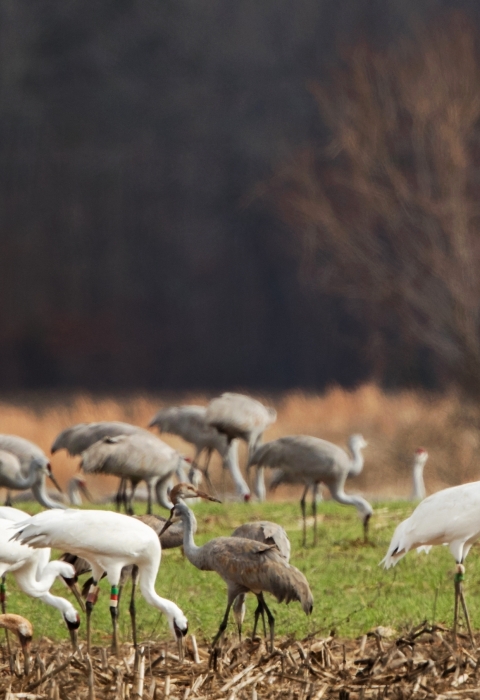What We Do
Water level manipulation, cooperative farming, mowing, and propagating native plants are some of the tools used to protect, restore, and enhance Wheeler National Wildlife Refuge. Sensitive areas are often closed to the public so that wildlife populations can feed and rest with minimal disturbance. Standardized ground and aerial wildlife surveys and vegetation surveys are conducted to inventory populations and document habitat use. Units are evaluated by how well they meet habitat and wildlife use objectives.
Management and Conservation
Cooperative farming
Cooperative farming is a mutually beneficial arrangement where the farmer is allowed to farm refuge land under certain guidelines and restrictions, including location of crops, techniques, crops planted, and chemicals used. Title 50, Part 29, of the Code of Federal Regulations and Service policies require that the value of a refuge’s share of cooperatively grown crops be set at rates that reflect the fees and charges received by private landowners in the vicinity for similar privileges. The value can be established through the use of competition in selecting cooperators or through an analysis of local market conditions to establish the prevailing rates in the nearest comparable area.
Wheeler NWR has an active cooperative farming program in which about 3,000-3,900 acres are planted annually. The goal of the program is to provide food and cover for migratory birds and other resident wildlife. The program supplements natural foods with grain foods, such as corn, milo, small seeded millets, and green browse. It is designed for farmers to buy the seed, plant, grow, and harvest the crop and leave a certain portion or share for the wildlife. Corn is usually chosen for refuge shares, although millet is planted in areas that remain wet too long for corn production.
Waterfowl Impoundments
Wheeler NWR manages 16 impoundments to provide approximately 2,000 acres of waterfowl habitat in open water, moist soil, and in areas where agricultural crops can be flooded. Management consists of manipulating water flows through 20 water control structures (WCS) consisting of concrete and/or corrugated metal pipes with flash board riser or screwgate structures. By adjusting the height of the control mechanism (screwgates and riser stoplogs), water levels are set and gravity-induced water flows can be created. In addition, many of the impoundments are located within two large dewatering units (White Springs and Rockhouse Buckeye) that utilize mechanical pumps to remove water.
Generally, impoundments are filled in the fall by rainfall or through spring seepage. Rarely can the refuge open WCSs and allow water to flow from the Wheeler Reservoir into the impoundments because the reservoir's water level has dropped (early to mid-September) prior to the time when filling is needed (late September or early October). Impoundments are not filled with water until farmers harvest crops and just prior to the time birds begin to arrive at the refuge.
Most impoundments, with the exception of the Display Pool at the Visitor Center, can usually be drained or partially drained by gravity into the reservoir or its tributaries before the water level is raised in the spring (early to mid-April) by opening various WCS. A portable pump is used to empty the Display Pool. Impoundment drawdown is initiated after waterfowl leave, generally in late February or March, depending on the impoundment and yearly conditions. In typical years, water has to be pumped out of the impoundments after the reservoir is raised in mid-April.
In the spring, pumps are used to draw down the White Springs Dewatering Unit (Whiteside Pump Station) and the Rockhouse Buckeye Dewatering Unit (Rockhouse Pump Station). These pumps are operated by TVA in cooperation with the refuge and the State of Alabama (the pumps also affect management units on the Swan Creek Wildlife Management Area just west of the White Springs unit) via a cooperative agreement. The costs are paid by the Service or cost-shared as follows: Whiteside Pump Station - May 1 to September 1 - State 20 percent, TVA 50 percent, and Service 30 percent; Rockhouse Pump Station - May 1 to September 1 - TVA 50 percent and Service 50 percent. The refuge pays 100 percent of pumping costs during the rest of the year when pumps are operated to dewater the units.
Impoundments and related structures are maintained annually as resources and conditions permit. When soil conditions are dry enough, unwanted vegetation (especially woody vegetation) is mowed, disced, or removed. Roadsides and the upper, dryer portion of the dikes are mowed annually. Areas that are farmed do not require as much maintenance.
Law Enforcement
Law enforcement is an integral part of managing the National Wildlife Refuge System. The Wheeler National Wildlife Refuge Complex is actively patrolled by Federal Wildlife Officers who are responsible for upholding state and federal laws and regulations that protect natural resources, the public, and employees.
